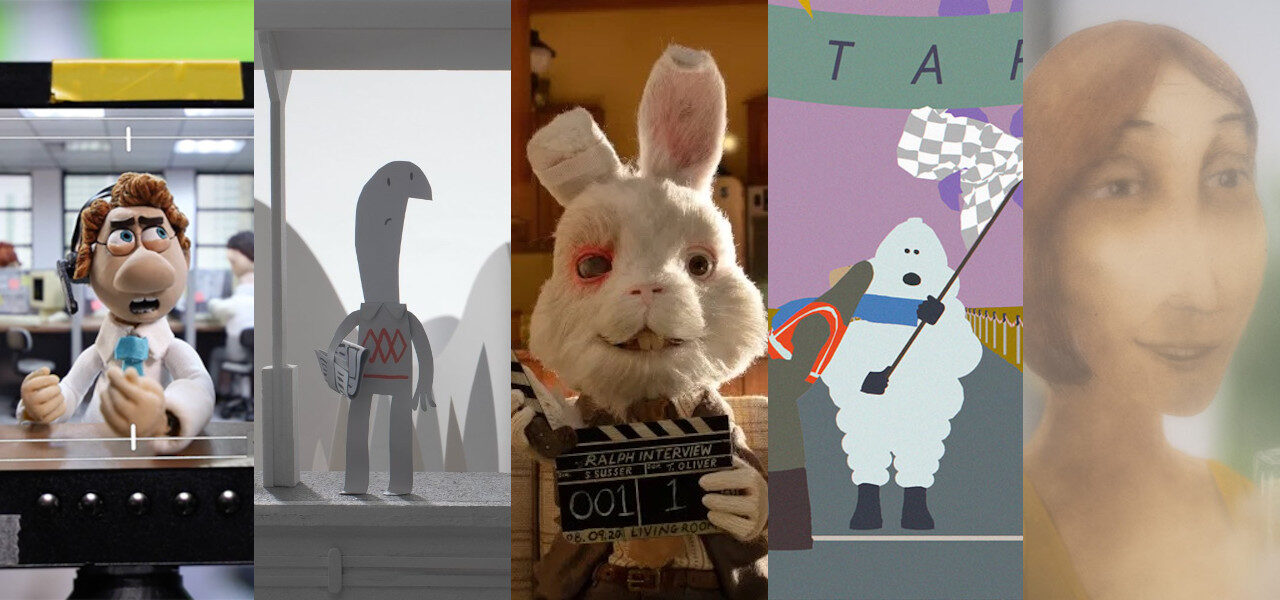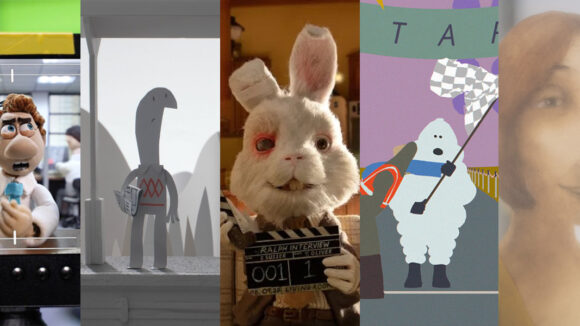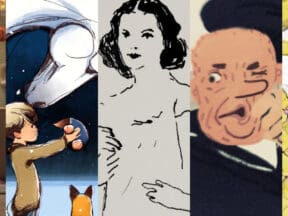

The Oscar Shortlist Interviews: What Each Filmmaker Learned Making Their Shorts
Fifteen animated shorts have been shortlisted for an Oscar this year.
To better understand how these films were crafted, we sent a series of questions to all the directors, to learn more about how they made their films. We are publishing their answers across three stories this week. This is the second piece in the series. Part one can be found here.
Our second question:
What did you learn through the experience of making this film, either production-wise, filmmaking-wise, creatively, or about the subject matter?
Lachlan Pendragon (An Ostrich Told Me the World Is Fake and I Think I Believe It)
The film was made in my mum’s living room during Covid lockdowns. I animated for about 10 months by myself one frame at a time. I’ve learned a lot about stop-motion animation. Everything from improving my character performances to sewing miniature trousers. This was a student film, so I’m incredibly eager to continue learning and making stuff. I’m very proud of the film and thankful to my university supervisors and supportive family who’ve been with me on the journey.
Juan Pablo Zaramella (Passenger)
I learned to avoid getting stuck with an empathizing character and to let the story expand the edges of the main theme. I reaffirmed that short films are a perfect experimental field where the public can be exposed to different experiences. It was nice to find out that people like the movie better after a second or third view. This is a characteristic of the works of art that I’ve liked the most throughout my life, and I feel proud that this is happening with Passenger.
Spencer Susser (Save Ralph)
When I started making Ralph, I, like most people, thought cosmetic animal testing was a thing of the past. I didn’t realize they still do this! I was shocked to learn how extreme it is and how it’s still happening on such a massive scale – four out of five countries still do it. I also learned that there are modern, non-animal, and scientifically proven testing methods that are far superior to animal testing. But laws banning this practice are needed to make a change. The more I got into it, the more I realized the film had to be made.
Sander Joon (Sierra)
The film went through many rewrites and I’m happy about where we landed. I learned that telling an honest personal story gives you the certainty that you really can’t go wrong with it. Also, letting your film crew loose to do what they do best will quite often bring something amazing to the film. For example, having some of Misha Panfilov’s music already composed before animating was definitely the key to coming up with the film’s ending scene.
Špela Čadež (Steakhouse)
Every film is a learning process at all levels. Co-production between the three countries was particularly difficult during the lockdown. One of the challenges was to find the right rhythm to tell the story. Dialogues played a special role. We realized that sometimes silence is much more powerful than any words. What strikes me most is the fact that the film opens viewers’ own, sometimes extremely personal, experiences of psychological violence.
Uri Lotan (Black Slide)
Clarifying the message of the film was a big challenge since it’s rooted in my real-life experiences. It was hard to think of the message in a removed, objective way; it was so subjective for me. This led me to try and focus on the emotional journey Eviah goes through. I wanted the viewer to be in his footsteps as he climbs up the stairs, to experience the day from his point of view. I found this experiential approach left a lot of room for the viewer to interpret the film and its message according to their own life and experiences. Most particularly, those who have lost a loved one got to relive their painful experience through Eviah’s, leaving them feeling just a little less alone with their grief.
Peter Baynton, Charlie Mackesy (The Boy, the Mole, the Fox and the Horse)
Mackesy:
I was grateful to be a part of a lot of the process – which was all new to me whether it was adapting, writing, co-directing, auditioning the cast… I was involved in so many different sides of the film. It was a very steep learning curve but everyone was patient and kind. I learned that listening is important and by discussing things – even if you see them differently – you can come to conclusions that feel right. It was a new experience working with others and being part of something much bigger than myself. I found out some new things about the characters, and I learned a great deal about myself.
Baynton:
I learned that you’re only as good as your team, and thanks to our brilliant producer we were fortunate enough to have the most incredible, dedicated, and talented crew. It’s impossible to have all the answers yourself, so listening to those around you is key.
Elizabeth Hobbs (The Debutante)
In making The Debutante, my producer Abigail Addison and I were very grateful to have been supported by the BFI through its Short Form Animation Fund, which is made possible thanks to National Lottery funding. This allowed us to take our time, find a good space for me to work, make mistakes, and be bold. We also had the creative luxury of working with three brilliant actors, and the chance to collaborate with composer Hutch Demouilpied and editor Mark Jenkins, who both brought so much to the film.
Wendy Tilby, Amanda Forbis (The Flying Sailor)
We learned that animating a 2d sailor strolling on a 3d pier is very complicated. We learned (again) that every film is about three times harder to make than we think it will be. We learned that when, at the outset of a project, we say to ourselves, “This one will be fast and loose!,” we shouldn’t believe it.
Laura Gonçalves (The Garbage Man)
It was my first professional solo film, and it was an important learning experience that helped me mature as a filmmaker. I wanted to make an animated short based on the real voices of my family that carried the spectator on a journey between the present and memories, going back and forward on the table, between talking heads and camera movements. This was possible thanks to the team who brought this idea to life. Production took three years, two of which were under Covid restrictions, so we had to learn how to work from home and communicate as a team without losing our objective. It was a very different way of making a film from what we are used to at BAP Animation Studios, where we share the same space and experiences during the making of the film as a team. But facing this reality it was important to learn how to deal with work from a distance. It made us appreciate even more the time we spent together making films, so we are happy to be back to normal now. On a personal level, I learned a lot about my family’s past. It brought us even closer together.
João Gonzalez (Ice Merchants)
I learned that sometimes you end up finding your best and most creative ideas while embracing your own limitations. In the case of this film, my (lack of) ability to draw hair on characters when I started the film made me design them wearing hats. Those hats ended up becoming a fundamental part of the film’s narrative. I discovered that finding solutions for our own technical “gaps” can be part of the process of finding our own artistic voice.
Robert-Jonathan Koeyers (It’s Nice in Here)
It’s Nice in Here is my first professional film and first time working with a team, so there have been a lot of valuable lessons and takeaways. As a multi-disciplinary artist, I often tend to be responsible for every piece of the process. With this film, I had the opportunity to create my own team and surround myself with people who could do things that I couldn’t. During production, I came to realize how important it is to be adaptable and to create a process that works best for you, as well as for the film. I wanted to keep editing the film and finding interesting and poetic associations between shots, but when I felt like we were setting things in stone I made sure that we created enough space for the animators, the art director, and for myself, to work on short additional shots that were not in the script or storyboard, much like B-roll footage. Being able to assemble these puzzle pieces and put them in the right places helped make the film feel so much more intuitive and poetic. I hope to approach my next film in a similar way and build on this further to see what will come out of it.
Amy Bench (More than I Want to Remember)
The film solidified my love for animation as a wonderful art form for expressing a deeply personal and serious subject matter, and for telling stories that otherwise might not be told. Another pleasant surprise for me was that as the film was shown around the country, although it was made for adults, it speaks to children and youth too. I realized, if the story and visuals are clear and direct, audiences of all ages can connect to its themes, which for me was an unexpected and thrilling discovery. And from Mugeni I’ve learned to never give up hope, that miracles do indeed happen.
Sara Gunnarsdóttir (director) Pamela Ribon (writer) (My Year of Dicks)
Ribon:
We made this before Roe V. Wade was overturned, so it went from being a sweetly nostalgic retelling of some of my weirdest high school adventures to a story about a girl who, if she were living in present-day Texas, was doing the most dangerous thing she could do with her future. I hope that it reminds people that women – and in this case, young women in particular – should have autonomy. They should be encouraged to explore their desires, find their pleasures, and seek experiences that illuminate love, respect, and the power of consent. This is a film about choice.
Jérémie Balais, Jeff Le Bars, Raúl Domingo, Colman Domingo (New Moon)
Jeff and I were used to just the two of us working and collaborating on our films. Working with Colman and Raúl on New Moon, we discovered how wonderful it was to delve deeper into each other’s strengths, talents, and skills. Colman has an incredible voice and a wonderful presence in front of the camera that was simply impossible not to use. He acted beautifully and danced wholeheartedly for the film and it was truly a pleasure to be able to rely on his physicality and movements to animate New Moon.

.png)
